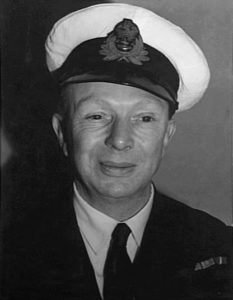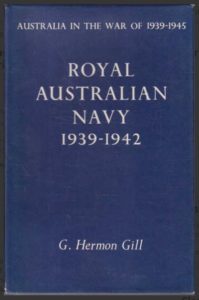- Author
- Editorial Staff
- Subjects
- Biographies and personal histories, History - WW2
- Tags
-
- RAN Ships
- None noted.
- Publication
- June 2021 edition of the Naval Historical Review (all rights reserved)
The name George Hermon Gill might mean little to a new generation of men and women serving in the RAN but in your careers you will almost certainly come across his volumes of naval history and will be rewarded by his great understanding of the contribution made by your predecessors in preserving the unique character of the Royal Australian Navy.
George Hermon Gill was born on 8 March 1895 in the London suburb of Fulham, the son of William Hermon Gill, a compositor in a printing works, and his wife Alice, née Clark. He was educated in London and at Scarborough in Yorkshire. In April 1910 George became an apprentice with the famous Aberdeen Line of steamships. In 1914 he obtained his second-mate’s certificate and in December that year came to Australia in SS Themistocles, which on her return voyage carried Australian troops of the 2nd AIF to Egypt. Gill served with the Aberdeen Line throughout World War I and in 1921 he gained his master mariner’s certificate. While serving as second officer in SS Miltiades he met Esther Paterson, an artist, who was a passenger in the ship, and romance blossomed.
Emigrating to Melbourne in 1922, he joined the shore staff of the Commonwealth Government Line of steamers. On 2 June 1923 George married Esther and they set up home in Melbourne’s Middle Park. He resigned his post in 1929 and took Esther on a visit to England. On return to Australia George turned his hand to freelance journalism, specialising in sea stories. From October 1933 he was employed as a newspaper reporter for the Star. With Frederick Howard, in 1934 he won a prize of £250 for the film scenario they based on Howard’s novel, The Emigrant. Gill’s ‘Walter and Hermon’ depicted a series of breathlessly unpunctuated sketches.
George Gill enlisted as a Lieutenant in the RANR in 1927 and was promoted Lieutenant Commander in June 1936. Mobilised for war service on 4 September 1939 he was sent to Newcastle, New South Wales, for duty with the Examination and Naval Control Services. In February 1940 he was posted to Navy Office, Melbourne. As the Publicity Censorship Liaison Officer in the Naval Intelligence Division, he established cordial relations with the press. In 1943 he was appointed as a Member of the Order of the British Empire (MBE) for distinguished service. He jointly edited the series of books HMAS (produced annually during 1942-45), took charge of the Directorate of Naval Intelligence naval historical records section, and in 1944 he was chosen to write thenaval volumes of the proposed Official History of Australia in World War II.

To enhance his research, early in 1945 Gill was sent on an extensive
study tour to Great Britain and the United States. Shortly after returning to Australia he ceased full-time service on 14 November 1945 but continued writing his history of the RAN. He was awarded the Volunteer Reserve Decoration (VRD), promoted Commander RANVR in June 1947, and transferred to the retired list on 8 March 1953.
In 1947 Gill became editor of the journal Navy and from the early 1950s edited the South Melbourne Record, an independent suburban weekly. He also wrote Three Decades (1949), a history of the State Electricity Commission of Victoria. Meanwhile, he worked on his two volumes of the official history and, as G. Hermon Gill, published Royal Australian Navy 1939-1942 and Royal Australian Navy 1942-1945. These volumes, published in Canberra in 1957 (Vol 1) and 1968 (Vol 2) were favourably reviewed, and he was praised for the balance and clarity of his narrative which set detailed descriptions of the RAN’s operations against the wider backdrop of the war. They remain the definitive history of the RAN during World War II. In 1981 Michael Montgomery with members of the Sydney Research Group used circumstantial evidence to challenge Gill’s account (Vol 1) of the loss of the cruiser, HMAS Sydney, but their criticisms have not overturned his general conclusions.

Standing 5 foot 9 1/2 inches (177 cm) tall and of medium build, Gill had fair curly hair and a florid complexion. As an historian, he was meticulous and avoided pedantry. Nor did he stand on formality. He was highly regarded in naval circles for his knowledge of the RAN, and his friends appreciated his kindly demeanour and the warmth of his personality. George Gill died on 27 February 1973 in East Melbourne and was cremated with Anglican rites.
Esther Paterson was born on 5 February 1892 at Carlton, Melbourne, second child of Scottish-born parents Hugh Paterson, artist, and his wife Elizabeth Leslie, née Deans. She was educated at Oberwyl School, St Kilda, and studied painting at the National Gallery of Victoria school in 1907-12. As a beautiful and talented young woman she became a member of Melbourne’s bohemian set. Best known for her street scenes and landscapes, she found further avenues for her talents in commercial art, book-illustrating and cartooning. Her portraits of uniformed and civilian officers, including Rear Admiral (Sir) Victor Crutchley and Commodore (Sir) John Collins, were reproduced in the HMAS series and in magazines, and have been shown at the Australian War Memorial, Canberra. The National Gallery of Victoria and the Geelong Art Gallery hold some of her work.
In 1950 Esther Paterson was elected a Fellow of the Royal Society of Arts and a council-member (1954-68) of the Victorian Artists Society and president (1966) of the Melbourne Society of Women Painters and Sculptors. She died on 8 August 1971 at Middle Park and was cremated with Anglican rites. Esther and George Gill remained childless.
Perhaps his finest epitaph comes from a fellow historian Anthony Macdougall who, writing in his epic Collins of the Sydney, says of Gill’s history of the RAN: ‘…it was a work in the tradition of the other acclaimed titles in the Australian official war series, whose writers (nearly all of them skilled former war correspondents, not retired senior officers or academically-trained historians) make the volumes the most vivid and readable official war histories in the world, with a unique Australian character in that they describe individual experiences and their actions and reactions instead of paraphrasing lifeless official documents by high commanders and government leaders.
References
Tom Frame, George Hermon Gill (1895-1973), Australian Dictionary of Biography.
Kenny, Peter F. We Who Proudly Serve, eBook, Xlibris AU, 2015.




